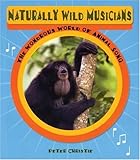The Solution to Reading Comprehension
Lessons & Units :: Naturally Wild Musicians: The Wondrous World of Animal Song 4th Grade Unit
Paired Text Questions: "Elephant Tales" and Naturally Wild Musicians: The Wondrous World of Animal Song
Lesson Plan
Naturally Wild Musicians: The Wondrous World of Animal Song

- Learning Goal
- Integrate information from the non-fiction passage “Elephant Tales” and the book Naturally Wild Musicians: The Wondrous World of Animal Song to compare the nature and purpose of elephant sounds with the sounds of other animals.
- Necessary Materials
- Provided:
- Questions
- Non-fiction reading passage “Elephant Tales”
Not Provided:
Naturally Wild Musicians: The Wondrous World of Animal Song
- Questions 1 and 2 refer to the non-fiction passage “Elephant Tales.” Questions 3 and 4 refer to the book Naturally Wild Musicians: The Wondrous World of Animal Song. Questions 5 and 6 refer to both the passage and the book.
- Student versions of the questions are in the 'Texts & Materials' tab.
Part 1: "Elephant Tales"
Read the passage “Elephant Tales” out loud to your students. Alternatively, students can read the passage independently or as a group.
Question 1: What are some of the sounds that elephants make?
Sample student answer: Students should name at least two elephant sounds described in the passage. These include gurgling, barking, squeaking, clapping, and roaring.
Question 2: What are some reasons that elephants make sounds?
Sample student answer: Responses may vary but should reflect the passage. Students should name at least two reasons that elephants make sounds. Elephants make sounds to express happiness, stay in touch when they become separated, and show that they recognize each other.
Part 2: Naturally Wild Musicians: The Wondrous World of Animal Song
Question 3: What do some of the songs described in Naturally Wild Musicians sound like?
Sample student answer: Students should describe the sounds of at least two types of animal song mentioned in the book. Examples include cicadas buzzing, European red deer roaring, Coqui frogs going ko-kee, and male bicolor damselfish chirping.
Question 4: What are the three main purposes of animal song described in Chapters 1-3 of Naturally Wild Musicians: The Wondrous World of Animal Song?
Sample student answer: The three main purposes of animal song are attracting mates, defending territory, and identifying one another.
Part 3: "Elephant Tales" and Naturally Wild Musicians: The Wondrous World of Animal Song
Question 5: What is similar about the way elephants sound and the way some of the animals described in Naturally Wild Musicians: The Wondrous World of Animal Song sound?
Sample student answer: Responses may vary, as long as they reflect the texts. For example, students may point out that both elephants and European red deer roar.
Question 6: What is similar about the purposes of elephant sounds and the purposes of animal song as described in Naturally Wild Musicians?
Sample student answer: Responses may vary, as long as they reflect the texts. For example, students may point out that elephants and the animals in Naturally Wild Musicians use sounds to communicate with each other. Elephants use sound to keep in touch when they become separated from their herd or to greet an elephant they recognize. Animals in Naturally Wild Musicians use sound to get each other’s attention, sometimes to attract mates and sometimes to discourage rivals.
Texts & Materials
Standards Alignment
(To see all of the ReadWorks lessons aligned to your standards, click here.)


